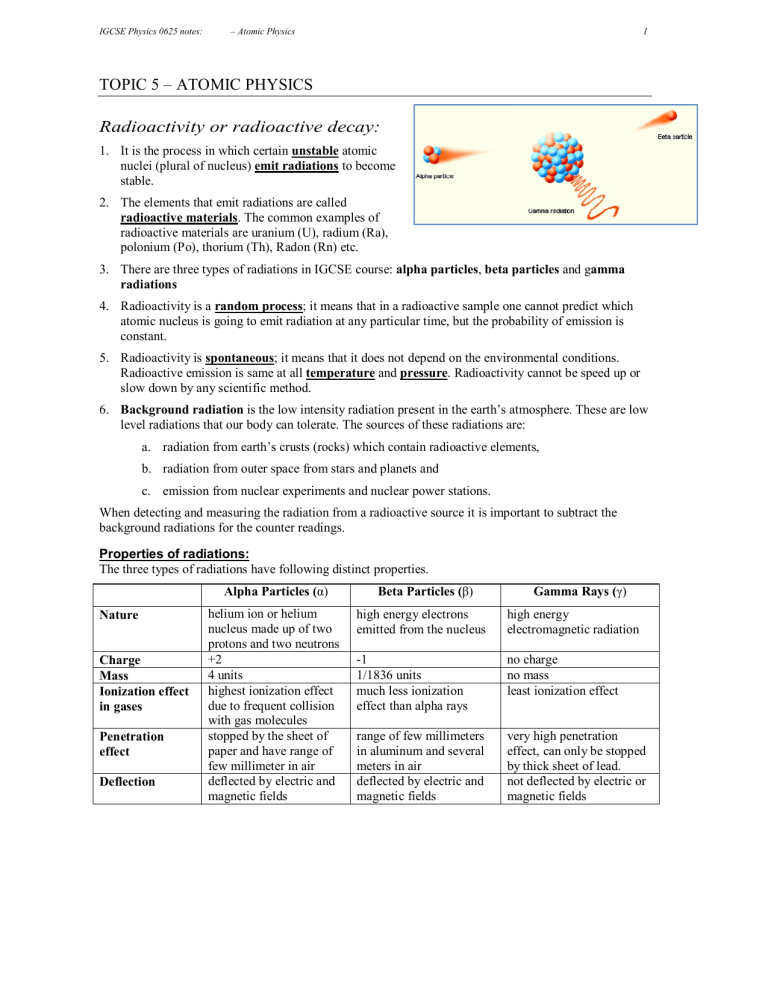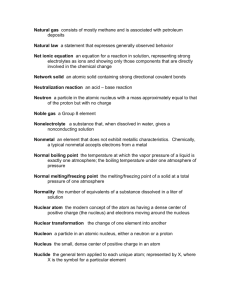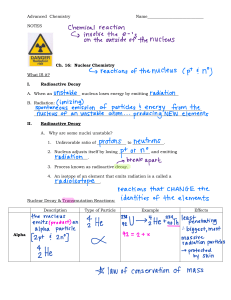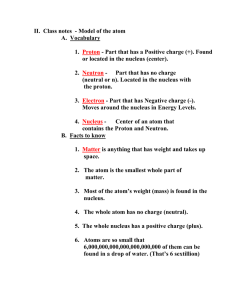
IGCSE Physics 0625 notes: – Atomic Physics 1 TOPIC 5 – ATOMIC PHYSICS Radioactivity or radioactive decay: 1. It is the process in which certain unstable atomic nuclei (plural of nucleus) emit radiations to become stable. 2. The elements that emit radiations are called radioactive materials. The common examples of radioactive materials are uranium (U), radium (Ra), polonium (Po), thorium (Th), Radon (Rn) etc. 3. There are three types of radiations in IGCSE course: alpha particles, beta particles and gamma radiations 4. Radioactivity is a random process; it means that in a radioactive sample one cannot predict which atomic nucleus is going to emit radiation at any particular time, but the probability of emission is constant. 5. Radioactivity is spontaneous; it means that it does not depend on the environmental conditions. Radioactive emission is same at all temperature and pressure. Radioactivity cannot be speed up or slow down by any scientific method. 6. Background radiation is the low intensity radiation present in the earth’s atmosphere. These are low level radiations that our body can tolerate. The sources of these radiations are: a. radiation from earth’s crusts (rocks) which contain radioactive elements, b. radiation from outer space from stars and planets and c. emission from nuclear experiments and nuclear power stations. When detecting and measuring the radiation from a radioactive source it is important to subtract the background radiations for the counter readings. Properties of radiations: The three types of radiations have following distinct properties. Alpha Particles (α) Nature Charge Mass Ionization effect in gases Penetration effect Deflection helium ion or helium nucleus made up of two protons and two neutrons +2 4 units highest ionization effect due to frequent collision with gas molecules stopped by the sheet of paper and have range of few millimeter in air deflected by electric and magnetic fields Beta Particles (β) Gamma Rays (γ) high energy electrons emitted from the nucleus high energy electromagnetic radiation -1 1/1836 units much less ionization effect than alpha rays no charge no mass least ionization effect range of few millimeters in aluminum and several meters in air deflected by electric and magnetic fields very high penetration effect, can only be stopped by thick sheet of lead. not deflected by electric or magnetic fields 2 Alpha Radiation (α or He): In an alpha-radiation the unstable parent nucleus decays into stable nucleus by emitting alpha particle. Alpha particle is a helium nucleus and which has two protons and two neutrons. The parent unstable nucleus changes into daughter nucleus. → + + (A is the mass number and Z is the proton number) Example 1: when a radium (Ra) nucleus of mass number 226 and proton number 88 emits α-particles, it decays into radon nucleus (Rn) of mass number of 222 and proton number of 86. The nuclear equation that follows is: → + + Example 2: plutonium - 240 decays into uranium - 236 by emitting alpha particle. → + + The value of A and Z must be balance on both sides of the equation. Beta Radiation (β or e ): In beta radiation, a neutron in the parent nucleus changes to proton and electron. The electron escapes out in the form of beta-particle and proton joins with the other protons in the nucleus. → + + Example 1: Radioactive carbon -14 (C), decays by emitting βparticle and changes into nitrogen -14 (N). → + + Example 2: Radioactive cesium -137 (Cs), decays by emitting βparticle and changes into barium - 137 (Ba). → + + Gamma Radiation (γ): The gamma radiation represents simple loss of energy from the nucleus. The gamma rays are released when an atomic nucleus releases its excess energy. Emission of γ-rays does not change the mass number or atomic number. If a nucleus is in exited state it can come to stable state by emitting a γ radiation. → + + IGCSE Physics 0625 notes: Atomic Physics 3 Half-life: 1. This is an average time for half of the atoms in a given sample are to be decayed or average count rate reduced to half of the original counts. It is denoted by symbol ½ . 2. For different radioactive elements half-life varies from millionths of second to millions of years. For radium it is 1620 years and for carbon-14 it is 5700 years. The table shows the half-lives of some of the common radioactive elements. Used of radioactivity: 1. Gamma rays are used to kill bacteria specially in sterilizing medical equipment and in preserving food. (medicine) 2. Alpha particles are used in smoke alarm for smoke detection. Alpha particles have high ionization effect and therefore they ionize the air molecules in between the two metal plates allowing the current to pass through. When smoke enters between the plates, some of the alpha particles are absorbed causing less ionisation to take place. This means a smaller than normal current flows so the alarm switches on. (safety and security) 3. Beta particles are used to monitor the thickness of the paper or metal sheets in manufacturing factory. Some of the radioactivity is absorbed by the foil and some passes through to the detector. The thicker the foil, the less radioactivity passes through it to the detector. The amount of radioactivity arriving at the detector is monitored by the computer. The thickness of the foil is controlled by the gap between the rollers. (industry) 4. Carbon-14 is used to find the age of living organism or plants. This method is called radioactive carbon dating. There's a small amount of radioactive carbon-14 in all living organisms. When they die no new carbon-14 is taken in by the dead organism. The carbon-14 it contained at the time of death decays over a long period of time. By measuring the amount of carbon-14 left in dead organic material the approximate time since it died can be worked out. (archeology) 5. Uranium -238 which eventually decays into lead is used to find the age of igneous rock. (archeology). 6. In radiotherapy the high doses of gamma radiation are used to kill the cancer cells. (medicine). 7. Find leaks or blockages in underground pipes. (construction) 4 Safety precautions in using radioactive substance: 1. Always use the radioactive symbol where there is a radioactive substance stored; 2. always be stored in a lead-lined container; 3. be handled only with tongs; 4. never be pointed at anyone; 5. never be put in pockets; 6. only checked by looking at them in a mirror. Rutherford alpha particle scattering experiment and atomic structure:1 J. J Thomson discovered the electron. He believed that the atom is a uniform sphere of positive charge with electrons (plums) embedded in it. This model explained the electrical neutrality of atom, but it failed to explain how these fundamental particles were arranged in the atom. His model was called ‘plum pudding’ model. 2 Ernest Rutherford (1871-1937) used α-particles to make it fall on the thin gold foil. He found that most of the α-particles were undeflected, some were scattered by appreciable angle and a few about 1 in 8000 surprisingly bounced back. To explain these results, in 1911 Rutherford proposed a ‘nuclear model’ of atom: 1. ‘Most of the space in an atom is empty. 2. All the positive charge and most of the mass of an atom formed a central dense part called nucleus of very small size compare to the size of atom. Size of a nucleus is 10,000 times smaller than the size of atom. 3. The negatively charged electrons surrounding the nucleus. 4. Total amount of negative and positive charge in a neutral atom is equal. 5. Proton Neutron Electron Charge Positive no charge negative Location in atom inside the Nucleus inside the Nucleus Outside the nucleus Relative mass to electron 1836 times 1836 times 1 6. The atomic or proton number Z of an atom is the number of protons in the nucleus. It is also the number of electrons in the atom when atom is neutral. 7. N is the number of neutrons in an atom. 8. In general A=Z+N where A is the nucleon number or mass number of an atom 9. General symbol for representing atom is for example 1 2 , , http://www.gcsescience.com/prad35.htm http://chemistry.tutorvista.com/inorganic-chemistry/brief-history-of-rutherford-s-and-his-scattering-theory.html IGCSE Physics 0625 notes: – Atomic Physics 5 Isotopes: 1. Isotopes of an element are atoms which have the same number of protons but different number of neutrons. 2. Isotopes have same chemical properties since they have same number of electrons and occupy the same place in periodic table. In Greek the ‘isos’ means same and ‘topos’ means place. 3. Hydrogen has three isotopes with one proton, dutreium one proton and one neutron, and tritium has one proton and two neutrons. 4. Each form of element is called nuclide. 5. Nuclides with same Z but different A are the isotopes. 6. Radioactive isotopes are termed radioisotopes or radio nuclides, their nuclei are unstable.






